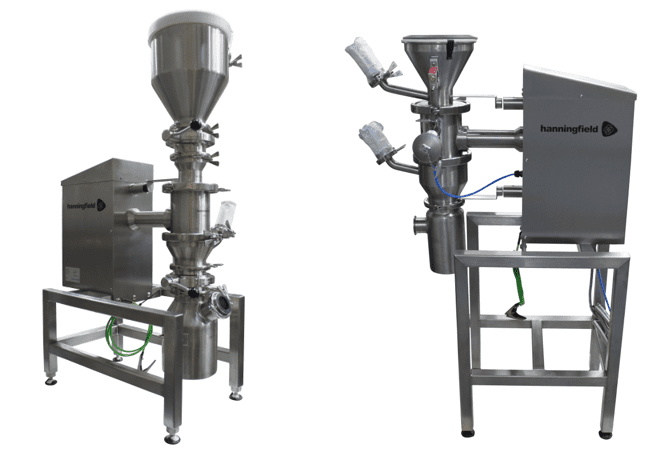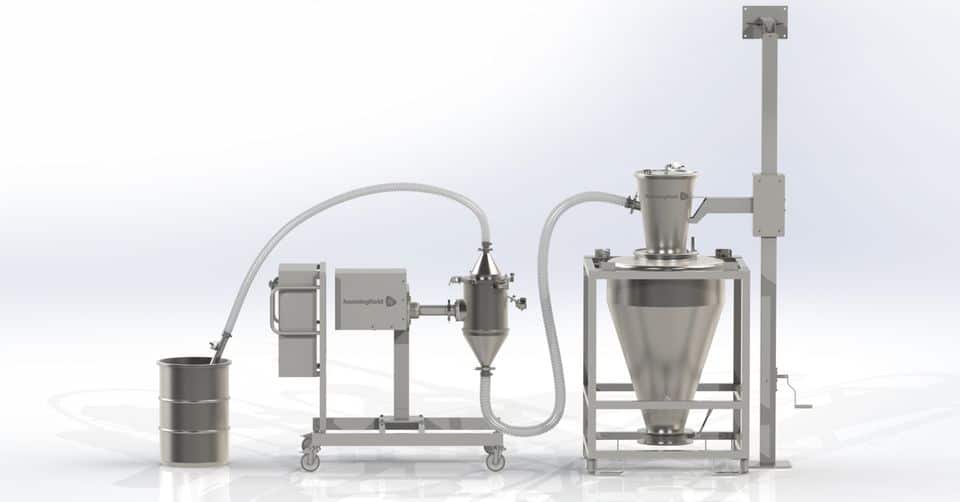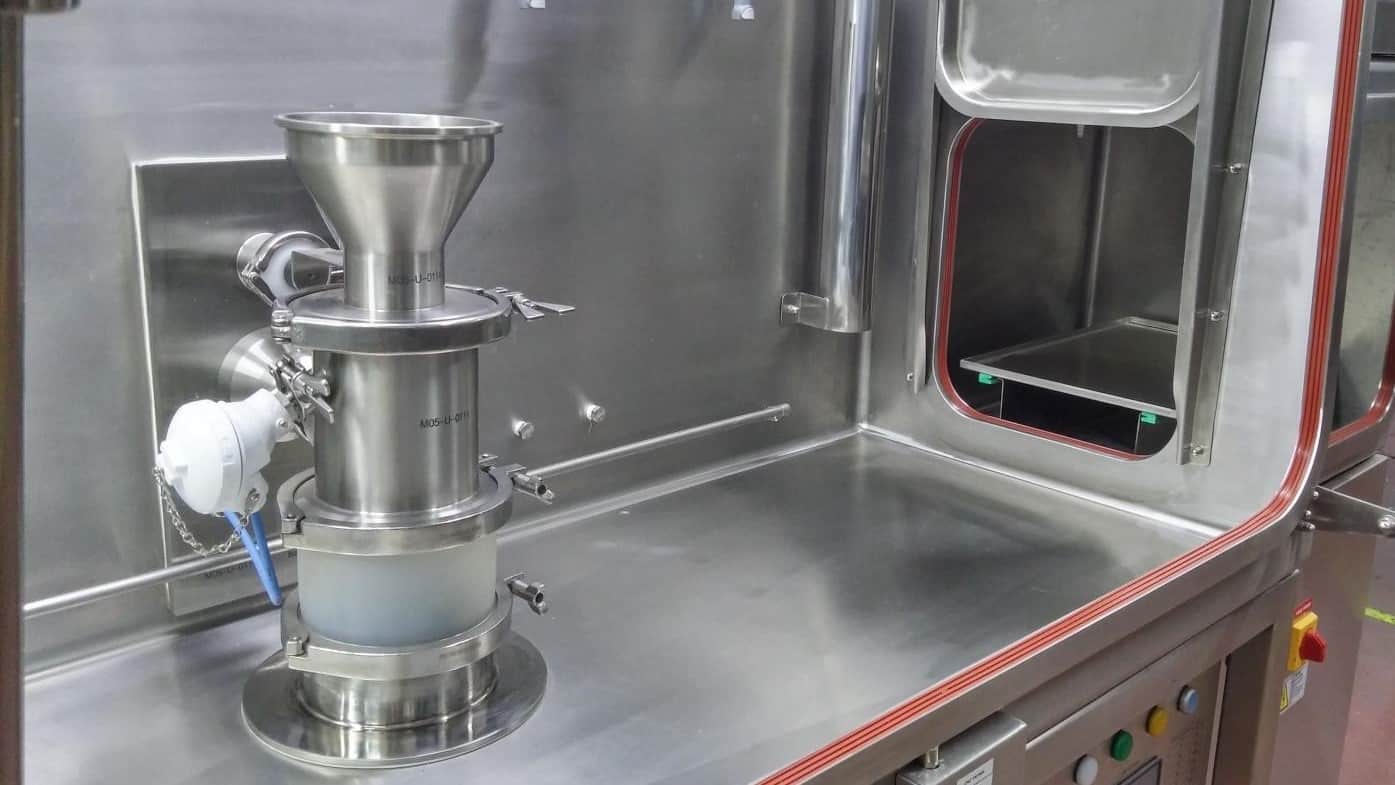
The increasing use of high-potency APIs has led to a growing need for total process containment (including dust-free milling).
These ingredients, which can often prove potentially dangerous if mishandled, can be a concern during the milling process as they are often associated with dust generation. In addition, some are known to be hazardous or even potentially dangerous to both the operator and the environment. Therefore, it is important to consider ways in which we can minimise this problem and achieve a dust-free milling process, preferably without restricting throughput.
There are a number of methods utilised for achieving containment when milling.
This article will focus on:
> Container-to-container milling
> In-line vacuum transfer
> Milling inside an isolator
Container-to-Container Milling
This method uses gravity to feed the product through the mill by positioning the containers on the inlet and outlet of the mill.
By positioning a container or IBC above the mill, and another container below, product will be released from the top container, milled and then passed directly into the lower container. A key benefit of this method is that it does not impede on process efficiency such as overall throughput.
This simple set-up is common in laboratories and R&D settings where dust containment is crucial for small processing environments.
Containment: With dust-tight transfer between the containers, the powder uses the effects of gravity to flow through and down. Not only does this technique keep the process in-line, but it also protects the operator from exposure to the product, which can prove to be a common problem. It is however essential to note, to allow for the displacement of air during the transfer process, the lower container must be fitted with a vent-filter.
Throughput: The in-line nature of this process is optimal and compact. While this system will not compete with the speed of transfer achieved using vacuum, the ease of bin changeover (either feeding drum or receiving drum) can offer capacity advantages over already existing process procedures.
This creates a completely contained, in-line approach for dust-free milling. Not only does this contain the product during the milling phase, but this is also a simple and highly successful method for transferring product from bin-to-bin and cone milling the product during transfer thus avoiding the need for double-handling.

In-Line Vacuum Transfer
Integrating Vacuum Transfer with milling offers an array of advantages to the process. Not only does this method keep the powder fully contained, but it also increases throughput whilst keeping the product cool. This enables for faster transfer to the downstream process.
Containment: This dust-tight transfer method ensures the powder is contained within the system. This protects the operator from exposure to the product, while minimising waste by preventing leakage.
Increased Throughput: Rather than relying on gravity to assist the process, in-line vacuum transfer pulls the product through the mill. This can dramatically increase the feed rate of the mill and to enhance the overall throughput.
Keeps the Product Cool: As the air used to transfer the product passes through the machine housing, it will help to keep the internal components of the mill and product itself cool. As a result of this, the reduced processing temperature helps to prevent caking and undesirable changes to the material properties.
Faster Transfer to Downstream Process: By using the system to influence the transfer process, the product can be easily transferred to a downstream process. This helps to transform dual-stage processes into a single process, by eliminating unnecessary storage and transport.
Feeding and discharging from a cone mill using vacuum is a particularly efficient method for successfully attaining dust-free milling. Using an in-line vacuum transfer system (such as the Hanningfield Uni-Vac) offers a range of advantages, enabling the matter to be routinely fed into the inlet chute and automatically drawn from the outlet of the mill (to a downstream process). This guarantees that from pick-up to discharge, the system is rapid and fully contained.
Alternatively, it is of interest to note that instead of vacuum transfer through the mill, the vacuum hopper can be situated on top of the mill to discharge directly into the inlet.

Isolator Milling
Another technique for containment of powder during milling is the use of an isolator or glove-box. This helps to guarantee all excess material remains contained. This method ensures the fine dust particles produced are not exposed to either the atmosphere or operator during processing.
Cone mill integration within the isolator is performed by means of through the wall fixing flange. This fixing flange and particular configuration of the cone mill allows for a physical division of the cone mill head by the technical area that is left outside the isolator. This configuration means that all cone mill cleaning operations are performed within the isolator by means of gloves or half-suit, reducing any risk of exposure for the operator and avoiding any transport to the cleaning room.
Containment: An isolator is one of the most widely recognised and widely used methods of containment. Indeed, the main purpose of the isolator is to prevent exposure, with typical operator exposure levels of < 0.1 µg/m3.
Throughput: At first thought, the isolator may represent an obstacle to increased throughput. However, by minimising the need for operator suiting or cumbersome containment, the purpose-built nature of the isolator provides a safe and ergonomic method for milling.
In addition to this, another benefit of isolator milling is for achieving a zoned area such as ATEX. The isolator itself creates an ATEX environment for milling, ensuring the entire process environment (including motors and controls) do not need to be changed to comply with the necessary requirements.

ATEX / Ex-Proof Compliant
All of our mills can be supplied for ATEX / ex-proof environments, so the container-to-container set-up is also suitable for ATEX / ex-proof applications. Read more about milling in explosive atmospheres here >>.
Conclusions
In today’s modern processing, the containment of dust is extremely important. This can be easily achieved during the cone milling stage, by employing one of the methods listed above. Each solution will be more or less suited to any particular application.
Get in Touch
For more information on how to achieve dust-free milling during processing, please send us a message using our Contact Form or call us on +44 (0)1702 549 777. A member of our engineering team will be happy to guide you through and select your best processing option.
To keep up-to-date with the latest news from Hanningfield you can follow us on LinkedIn.